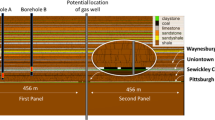Abstract
Longwall-induced deformations could jeopardize the mechanical integrity of shale gas well casings positioned in the abutment pillar of a longwall mine. The in situ and induced fracture networks surrounding the gas well could provide pathways for gas flow into the mine creating safety concerns. Hence, this study by the National Institute for Occupational Safety and Health (NIOSH) develops a discrete fracture network (DFN) model to characterize the fractures in the overburden based on geomechanical analyses of mining-induced fracture apertures at a study site in southwestern Pennsylvania. The apertures from the geomechanical model are used to develop a stochastic DFN model of the site in fracture flow code (FFC). Multiple realizations of the stochastic DFN model that replicate potential fracture geometries are simulated, and the fracture permeability is compared with field measurements. A maximum field measurement of 5.03 × 10−12 m2 (5080 mD) and 3.82 × 10−13 m2 (386 mD) was estimated over the abutment pillar at the Sewickley and Uniontown horizon, respectively. The results show that the average permeabilities from the DFN model agree closely with the field measurements. In addition, the comparison of all the field measurements and 100 DFN realizations show the model is representative of field conditions. These findings provide critical information regarding fracture characteristics in the overburden, which will further be used to predict potential shale gas flow to the mine in the event of a casing breach for an unconventional gas well.









Similar content being viewed by others
References
Su DW, Zhang P, Van Dyke M, Minoski T (2019) Effect of longwall-induced subsurface deformations on shale gas well casing stability under deep covers. Int J Min Sci Technol 29(1):3–8
Zhang P, Su D, Lu J (2019) Influence of longwall mining on the stability of shale gas wells in barrier pillars. in American Rock Mechanics Association. New York
Zhang P, Dougherty H, Su D, Trackemas J (2019) Influence of longwall mining on the stability of gas wells in chain pillars. in Proceedings of the 38th International Conference on Ground Control in Mining
Schatzel SJ, Karacan CÖ, Dougherty H, Goodman GV (2012) An analysis of reservoir conditions and responses in longwall panel overburden during mining and its effect on gob gas well performance. Eng Geol 127:65–74
Itasca U (2013) 3DEC—3 dimensional distinct element code. Itasca Consulting Group Inc., Minneapolis
Palchik V (2005) Localization of mining-induced horizontal fractures along rock layer interfaces in overburden: field measurements and prediction. Environ Geol 48(1):68–80
Palchik V (2003) Formation of fractured zones in overburden due to longwall mining. Environ Geol 44(1):28–38
Watkins E, GV, Schatzel S, Hollerich C, Addis J (2020) Permeability determination for potential interaction between shale gas wells and the coal mine environment due to longwall-induced deformations., in 2020 SME Annual Meeting and Exhibit. Phoenix, AZ
Holla L, Buizen M (1991) The ground movement, strata fracturing and changes in permeability due to deep longwall mining. Int J Rock Mech Min Sci Geomech Abstr. Elsevier
Zhang X, Sanderson D, Harkness R, Last N (1996) Evaluation of the 2-D permeability tensor for fractured rock masses. Int J Rock Mech Min Sci Geomech Abstr. Elsevier
Heller R, Vermylen J, Zoback M (2014) Experimental investigation of matrix permeability of gas shalesexperimental investigation of matrix permeability of gas shales. AAPG bulletin 98(5):975–995
Ajayi K, Khademian Z, Schatzel S, Watkins E, Gangrade V (2021) Numerical modeling of longwallinducedpermeability under shallow cover, in mine Ventilation. CRC Press pp 389–397
Acknowledgements
The authors acknowledge the contributions of Dr. C. Ӧzgen Karacan during the review of the modeling approach. Data from this manuscript had been presented at the North American Mine Ventilation Symposium, June 2021, Rapid City, SD [12].
Author information
Authors and Affiliations
Corresponding author
Ethics declarations
Conflict of Interest
The authors declare no competing interests.
Disclaimer
The findings and conclusions in this paper are those of the authors and do not necessarily represent the official position of the National Institute for Occupational Safety and Health, Centers for Disease Control and Prevention. Mention of any company or product does not constitute endorsement by NIOSH.
Additional information
Publisher's Note
Springer Nature remains neutral with regard to jurisdictional claims in published maps and institutional affiliations.
Rights and permissions
About this article
Cite this article
Ajayi, K.M., Khademian, Z., Schatzel, S.J. et al. A Discrete Fracture Network Model for Prediction of Longwall-Induced Permeability. Mining, Metallurgy & Exploration 39, 1793–1800 (2022). https://doi.org/10.1007/s42461-022-00637-6
Received:
Accepted:
Published:
Issue Date:
DOI: https://doi.org/10.1007/s42461-022-00637-6




